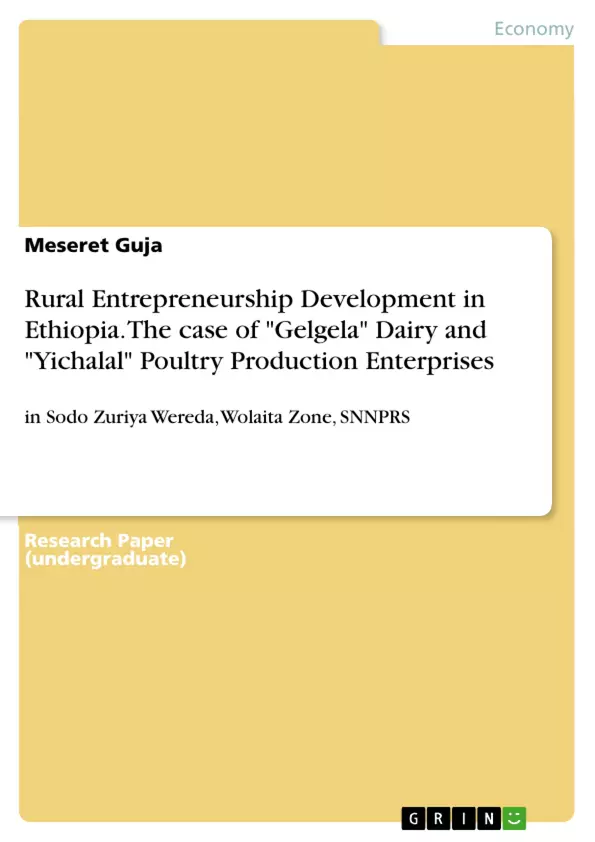The major objective of the study was to assess challenges and opportunities for rural entrepreneurship development based on empirical evidence from "Gelgela" Dairy and "Yichalal" Poultry Production Enterprises located in Bosa Qacha Kebele of Sodo Zuriya Wereda of Wolaita Zone.
This study investigated the challenges and opportunities for rural entrepreneurship development in Ethiopia taking the case "Gelgela" Dairy and "Yichalal" Poultry Production Enterprises located in Bosa Qacha Kebele of Sodo Zuriya Wereda of Wolaita Zone in SNNPRS. Regardless of the fact that some of the challenges and opportunities were shared in common with enterprises engaged in similar ventures, it would be difficult to infer the results to the other enterprises within another Weredas of the same Zone since rural locations differ in many aspects. Consequently, findings cannot be generalized to broader rural locations in SNNPRS and the whole country.
Inhaltsverzeichnis (Table of Contents)
- ACKNOWLEDGMENT
- ABSTRACT
- 1. INTRODUCTION
- 1.1. Background of the Study
- 1.2. Significance of the Study
- 1.3. Delimitation
- 1.4. Objectives of the Study
- 2. METHODOLOGY
- 2.1. Description of the Study Area
- 2.1.1. Sodo Zuriya Wereda
- 2.1.2. Description of Bossa Qacha Kebele
- 2.2. Map of the Study Area
- 2.3. Research Design
- 2.4. Data Sources
- 2.5. Data and Data Types
- 2.6. Method of Data Analysis
- 3. RESULTS AND DISCUSSIONS
- 3.1. General Overview on the Performance of all Enterprises in the Wereda
- 3.2. Types of Rural Enterprises and the Scales of Initial Capitals
- 3.3. Performance of the ‘Gelgela Dairy Production Enterprise’
- 3.4. Performance of the 'Yichalal' Poultry Enterprise
- 3.5. Demographic Characteristics of members of Enterprises
- 3.6. Potential Challenges of all Enterprises in the Wereda
- 3.7. Challenges of the 'Gelgela' Dairy and ‘Yichalal' Poultry Enterprise
- 3.8. Opportunities for the ‘Gelgela' Dairy and ‘Yichalal' Poultry Enterprises
- 4. CONCLUSION AND RECOMMENDATIONS
- 5. REFERENCES
- ANNEX
Zielsetzung und Themenschwerpunkte (Objectives and Key Themes)
This study aims to identify the potential challenges of rural entrepreneurship development in Ethiopia, assess opportunities for the development of rural entrepreneurship, and suggest remedial measures to address the problems faced by rural entrepreneurs. It focuses on the 'Gelgela' Dairy and 'Yichalal' Poultry Production Enterprises in Sodo Zuriya Wereda, Wolaita Zone, SNNPRS.
- Challenges of Rural Entrepreneurship Development in Ethiopia
- Opportunities for Rural Entrepreneurship Development
- Remedial Measures for Challenges Faced by Rural Entrepreneurs
- Case Study Analysis of 'Gelgela' Dairy and 'Yichalal' Poultry Production Enterprises
- Assessment of the Performance and Development of Selected Enterprises
Zusammenfassung der Kapitel (Chapter Summaries)
- Chapter 1: Introduction
- This chapter provides the background of the study, highlighting the significance of rural entrepreneurship in addressing rural poverty and achieving balanced regional development. It also outlines the study's objectives and scope.
- Chapter 2: Methodology
- This chapter describes the study area, research design, data sources, data types, and method of data analysis used to conduct the research. It provides a detailed overview of the research approach.
- Chapter 3: Results and Discussions
- This chapter presents the findings of the study. It analyzes the performance of various enterprises in the Wereda, highlighting the challenges faced by the 'Gelgela' Dairy and 'Yichalal' Poultry enterprises. It also explores the opportunities for their growth and development.
Schlüsselwörter (Keywords)
This study focuses on rural entrepreneurship, enterprise development, and the specific cases of the 'Gelgela' Dairy and 'Yichalal' Poultry Production Enterprises in the Wolaita Zone of Ethiopia. Key terms and concepts include challenges, opportunities, rural poverty, employment, rural-urban migration, balanced regional development, enabling environment, capacity building, capital provision, market competition, input prices, and microfinance institutions.
- Quote paper
- Meseret Guja (Author), 2022, Rural Entrepreneurship Development in Ethiopia. The case of "Gelgela" Dairy and "Yichalal" Poultry Production Enterprises, Munich, GRIN Verlag, https://www.grin.com/document/1183776



